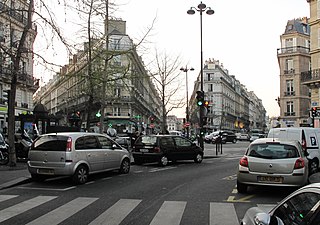Pocket square 'Paris Street; Rainy Day' Gustave Caillebotte
This complex intersection, just minutes away from the Saint-Lazare train station, represents in microcosm the changing urban milieu of late nineteenth-century Paris. Gustave Caillebotte grew up near this district when it was a relatively unsettled hill with narrow, crooked streets. As part of a new city plan designed by Baron Georges-Eugène Haussmann, these streets were relaid and their buildings razed during the artist’s lifetime. In this monumental urban view, which measures almost seven by ten feet and is considered the artist’s masterpiece, Caillebotte strikingly captured a vast, stark modernity, complete with life-size figures strolling in the foreground and wearing the latest fashions. The painting’s highly crafted surface, rigorous perspective, and grand scale pleased Parisian audiences accustomed to the academic aesthetic of the official Salon. On the other hand, its asymmetrical composition, unusually cropped forms, rain-washed mood, and candidly contemporary subject stimulated a more radical sensibility. For these reasons, the painting dominated the celebrated Impressionist exhibition of 1877, largely organized by the artist himself. In many ways, Caillebotte’s frozen poetry of the Parisian bourgeoisie prefigures Georges Seurat’s luminous Sunday on La Grande Jatte—1884, painted less than a decade later.
Description:
The tone of the light indicates that the painting is set on a wintery afternoon, and the two main figures walk underneath an umbrella. They are dressed in the height of contemporary Parisian fashion. She wears a hat, veil, diamond earring, demure brown dress, and a fur lined coat, described in 1877 as "modern – or should I say, the latest fashion". The man wears a moustache, topcoat, frock coat, top hat, bow tie, starched white shirt, buttoned waistcoat and an open long coat with collar turned up. They are unambiguously middle class. Some working class figures may be seen in the background; a maid in a doorway, the decorator carrying a ladder, cut-off by the umbrella above him. Caillebotte juxtaposes the figures and the perspective in a playful manner, with one man appearing to jump from the wheel of a carriage; another pair of legs appear below the rim of an umbrella.
The painting does not present a convivial mood. The figures seem mostly isolated, and their expressions are largely downcast. They appear to hurry rather than stroll through the streets, absorbed in their own thoughts. The umbrellas shield them, in the words of Rose-Marie Hagen, "not just from the rain, but, also it seems, from other passers by".Characteristic of the positioning of the figures, the heads and eyes of the main couple are faced away from the man approaching them from their right. Hagen believes that given their close quarters, they will both be unable to comfortably step out of the man's way, but also their averted gaze applies equally to the viewer, who looks from a perspective equal to us Caillebotte reproduces the effect of a camera lens in that the points at the center of the image seem to bulge. He also recreates the focusing effect of the camera in the way that it sharpens certain subjects of an image, but not others. The same purpose is seen in the overall clarity of the image. The foreground is in focus, but slightly smudged; the middle ground has sharp, clear edges and well defined subjects, and the background fades into the distance, becoming more and more blurry the farther back the eye travels. He makes the middle ground section more clear, mimicking the effect of a camera.
The figures appear to have walked into the painting, as though Caillebotte was taking a snapshot of people going about their day; in fact, he spent months carefully placing them within the pictorial space. The painting is highly linear; its focus draws the viewer's eye to the vantage point at the center of the buildings in the background. The strong vertical of the central green lamp post divides the painting; a horizontal alignment breaks the painting into quarters; the gaslight at the center of the picture throws shadows on the wet cobblestones, and divides the composition in two. Cobblestones dominate one full quarter of the canvas.

Paris Street; Rainy Day gives a view from the eastern side of the Rue de Turin, looking north toward the Place de Dublin. The neoclassical buildings reflect the construction works of Baron Haussmann. The view shown is spacious, and details a broad view of a number of streets. Although the ashlar facades of the buildings might today seem uniform, at the time they would have been modern and fresh – in Caillebotte's youth the area was a hill just beyond the city edge just beginning to be developed as a residential center for the bourgeoisie.
Three roads are visible on the northern side of the square: the rue de Moscou (left), the rue Clapeyron (center), and a continuation of the rue de Turin (right), which runs from the foreground and into the background. The square is crossed by the rue de Saint-Pétersbourg, suggested by the line of the buildings to the left and a break in the buildings to the right. The point of view of the roads and the buildings portrayed allows Caillebotte to use two-point perspective.
The ground floor of the building between the Rue de Moscou and the Rue Clapeyron, showing a 'pharmacie' sign in the painting, still houses a pharmacy today.


More: link
- fabric: 100% silk
- size: 40 x 40 cm
- handrolled edges
- Paint: Bank of the Oise at Auvers (1890)
- Panter: Gustave Caillebotte (French, 1848-1894)
- Source: Art Institute of Chicago










